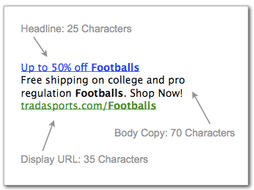Pay-Per-Click (or PPC) adverts are an excellent way to drive relevant, targeted traffic to your website or landing page. They may look simple, but with an effectively managed campaign there’s a lot going on in the background to make these nifty little ads appear at the most opportune moments, often at the very top of Google search results pages. While formulating the perfect PPC campaign will help your ad get seen by the right people at the right time, tempting them to click is another game entirely.
The best examples of PPC ads use every trick in the book to help them stand out and earn clicks, and I’m going to share a few basic tips with you that will help you turn your simple PPC ads into powerful advertising tools.
 First off, it’s worth noting that PPC adverts have 3 main components: a short heading, a bit of room for some main copy, and a link. There are also ‘ad extensions’ which can help you add more links to your ad, but for the purposes of this article we’re just going to assume you’re crafting a standard, extension-free advert. Despite the apparent simplicity of the ad’s makeup, each of these elements needs to work overtime to turn valuable impressions into invaluable clicks.
First off, it’s worth noting that PPC adverts have 3 main components: a short heading, a bit of room for some main copy, and a link. There are also ‘ad extensions’ which can help you add more links to your ad, but for the purposes of this article we’re just going to assume you’re crafting a standard, extension-free advert. Despite the apparent simplicity of the ad’s makeup, each of these elements needs to work overtime to turn valuable impressions into invaluable clicks.
Be sensible. Include keywords to reassure people
If a customer is presented with a PPC ad, they have to have searched for something on Google. Obviously, this means they are looking for something specific – something your keyword campaign has hopefully already taken advantage of. Referencing these same keywords in the advert itself will reassure customers, making the ad seem more relevant to them and increasing your chances of earning a click as a result. For example, if someone searches for “wooden flooring”, they’re more likely to click on an ad that uses this phrase than something more ambiguous like “flooring specialists”. Another big win for using keywords in ad copy is that they usually appear in bold, helping your ad to stand out even more.
Be clever. Write a compelling headline
The heading on a PPC ad will be the first thing that draws attention; they’re bolder and bigger than the rest of the ad so you’ve really got to make them work hard to engage people. A good rule of thumb is to make the headline as descriptive as possible, usually highlighting a product or service, like “Expert Wooden Floor Fitters”. If you’re a local business, drop the place name into the title to gain instant relevancy points, such as “Edinburgh Floor Fitters”. Another approach is to highlight an immediate benefit like an offer or perk, such as “Award Winning Wood Floors” or “Free Wood Flooring Quote”.
If you have a brand that’s well known you might be tempted to drop this into the heading of your advert (e.g. “Affordable Laptops at Argos”) – don’t! Your company name will already appear in the URL beneath your ad and most people will search for a service or product directly rather than a specific brand. It’s valuable real estate so you don’t want to repeat yourself.
Be literal. Make your ‘call to action’ clear as day
If you’re a copywriter like me, or if you spend a lot of time designing ads and writing marketing content, you’ll be used to taking your sweet time to subtly craft and shape your brand’s message. There’s no reason a PPC ad can’t be on brand, but make sure you hit people with a punchy and direct CTA; tell them precisely what you want them to do. Read John McGarvey’s article, Six Ways To Craft a Good Call To Action for some helpful tips on how to do this. So many ads fail to hit this particular nail on the head and it’s the essential mechanism for turning an impression into a click. Depending on what you’re offering, your CTA might be as simple as “Buy Now” or “Get Your Free Quote”, or could be as complex as, “50% off Wooden Flooring – Call Now”. Either way, the idea is to make it clear to people in no uncertain terms what the trade-off is – what are you giving them for their very valuable click? A chance to buy something? A free quotation or consultation? More information? Be literal.
Be loud. Capital letters are your friend.
Your headline is a title, so write it like one. There are countless ads out there that don’t capitalise on this very simple rule and they more than likely slip by unnoticed, or at the very least un-clicked. Using capitals on the initial letters of every word can really make your ad stand out, more so than you might think. Consider the difference between “Sale now on” and “Sale Now On”. The latter commands far more attention. You can also squeeze additional value out of your ad link by capitalising the words in your URL, for example ‘www.TheWoodFloorCompany.co.uk’ carries more impact than ‘www.thewoodfloorcompany.co.uk’.
Finding the right words for your ad is one thing, presenting them in the right way is another, and they’re mutually important. If you’ve got the capacity to A/B test your ads (or run more than a couple of ads in an ad group), this can also provide valuable insight into how they can be further tweaked to maximise your click through rate (or CTR). At the very minimum though, following the above tips should put you on track to creating some powerful and effective Pay-Per-Click ads for your business.
—
Was this article useful? Don’t forget to comment, share and join us on Twitter @YellBusiness. You can also tweet me @pro_copywriter if you have any questions about this article.





